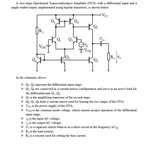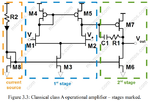robi10101298
Junior Member level 2
Hello, I need to implement the following circuit in LTSpice but I don't know what VCM, Vg,VCC and C infinite are  ...Can you help me with the symbols for it? Also, the scheme implemented by me it's ok? Thanks!
...Can you help me with the symbols for it? Also, the scheme implemented by me it's ok? Thanks!


- - - Updated - - -
I don't know who's R2...VCC= 10V;VCM = 1.5V;vg is a sine wave with a frequency of 1 kH, R1 it's 15k..I need to: a)Calculate the theoretical expressions of the DC collector currents of bipolar transistors Q1–Q8, considering VBE≈ 0.6V. Calculate the theoretical expression of the small-signal voltage gain Av= vo/vg. b)choose a value for R2 and C∞) in order to have a(theoretical)gain value Av= 1500.


- - - Updated - - -
I don't know who's R2...VCC= 10V;VCM = 1.5V;vg is a sine wave with a frequency of 1 kH, R1 it's 15k..I need to: a)Calculate the theoretical expressions of the DC collector currents of bipolar transistors Q1–Q8, considering VBE≈ 0.6V. Calculate the theoretical expression of the small-signal voltage gain Av= vo/vg. b)choose a value for R2 and C∞) in order to have a(theoretical)gain value Av= 1500.


